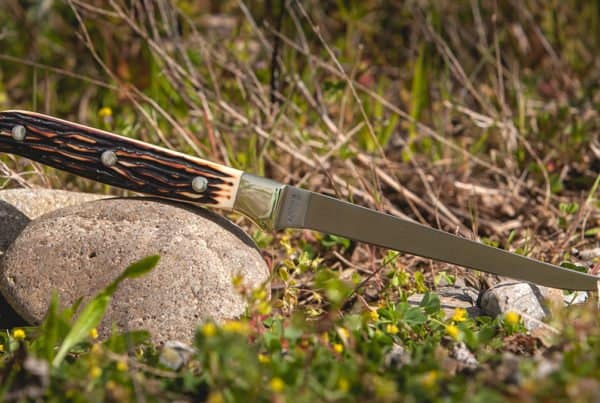For hunters of any region and era, the most essential tool in their kit is a knife. Australia hosts some of the world’s best master knife makers and a custom-made hunting blade is not out of reach of the ordinary man or woman. The following details the concept, making and use of an Australian hunting knife.
Once you have gained a little experience you can appreciate the often subtle differences between a quality item and a run-of-the-mill specimen. This applies to cars, boats, rifles, optics or, in fact, any item that we may use. It certainly applies to knives.
Top-end factory knives and custom-made knives represent a substantial investment and it took three or four years of deliberation before committing to first custom blade. Nowadays, with new state laws further enhanced by the events of September 11, we can unfortunately no longer carry a pocketknife everywhere, as were our wonts for several decades.
What’s the Best Folding Hunting Knife?
Although many will often choose a fixed blade hunting knife when they are in the great outdoors, it’s very possible that you need something smaller based on your particular circumstance.
Although the image of a hunter with a knife dangling from his belt is a popular one, those knives aren’t always practical—they can, for example, sometimes get in the way as you attempt to sneak through the undergrowth.
The traditional old hunting knife also leaves a lot to be desired when compared to more modern offerings, particularly from a hygiene perspective. No longer the wood, stacked leather and bone of the frontier but impervious plastics, rubberized handles and G10 are the order of the day when it comes to the handle of a hunting knife.
The convenience of a knife that can fit in a pocket and fold can’t be underestimated.
It’s worth noting that it’s just as important that your knife perform other tasks in the field beyond just skinning and processing the game you are hunting. For example, you may need to trim vegetation around a hide, carry out emergency repairs or adjustments to your firearm or bow, prepare food if you’re out for a while and open a beer after a successful hunt.
Therefore, please consider knives which also contain other tools such as;
- saw
- can/bottle opener
- dedicated gutting blade/hook
- awl
- screw drivers
- socket for hex bits
Fixed Blade Hunting Knives
Fixed-blade versus a folding knife is both personal and practical. If the game you hunt is large and the terrain more rugged, a fixed blade knife is often a better option for its strength and dependability.
Hunting knives include the puukko, the yakutian knife and the Sharpfinger. Most American designs are based on a smaller version of the Bowie knife. Knifemaker Bob Loveless popularized the Drop point hunting knife and William Scagel popularized the Camp knife.
What is a Definition of a Knife?
A knife is a tool with a cutting edge or blade attached to a handle. Mankind’s first tool, knives were used at least two-and-a-half million years ago, as evidenced by the Oldowan tools. Originally made of rock, bone, flint, and obsidian, over the centuries, in step with improvements in metallurgy or manufacture, knife blades have been made from bronze, copper, iron, steel, ceramics, and titanium. Most modern knives have either fixed or folding blades; blade patterns and styles vary by maker and country of origin.
What Knife can you Own in Your State?
You can own any Folding Knife and Fixed Blade Knife that IS NOT listed in the Prohibited Weapons Schedule (or Category M Weapons for Queensland residents) in your state. If there is no definition for the state you live in, it DOES NOT necessarily mean the knife is legal. We will deal with that situation later on.






